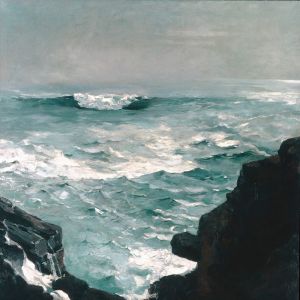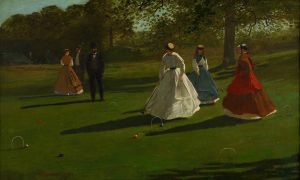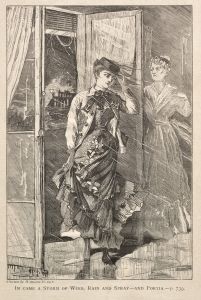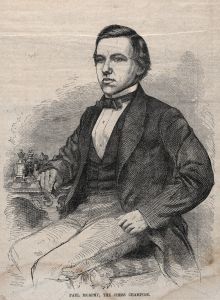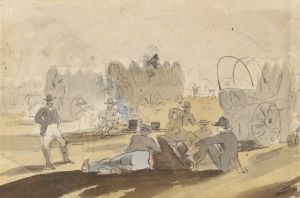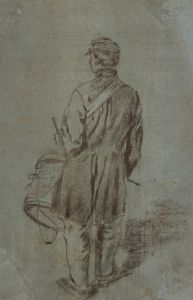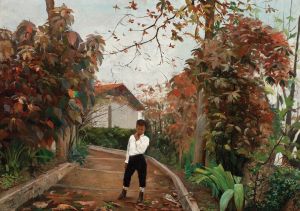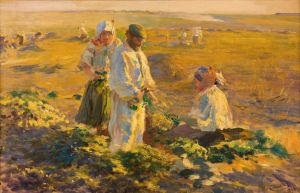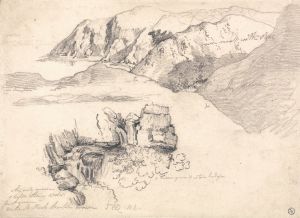
Tree Roots on a Hillside, Prout’s Neck
A hand-painted replica of Winslow Homer’s masterpiece Tree Roots on a Hillside, Prout’s Neck, meticulously crafted by professional artists to capture the true essence of the original. Each piece is created with museum-quality canvas and rare mineral pigments, carefully painted by experienced artists with delicate brushstrokes and rich, layered colors to perfectly recreate the texture of the original artwork. Unlike machine-printed reproductions, this hand-painted version brings the painting to life, infused with the artist’s emotions and skill in every stroke. Whether for personal collection or home decoration, it instantly elevates the artistic atmosphere of any space.
"Tree Roots on a Hillside, Prout’s Neck" is a painting by the renowned American artist Winslow Homer, created in 1895. Homer is celebrated for his mastery in capturing the American landscape and the human experience within it, and this work is a testament to his skill and vision.
Winslow Homer was born in 1836 in Boston, Massachusetts, and he began his career as a commercial illustrator before transitioning to painting. He is often associated with the Realism movement and is particularly known for his marine subjects and landscapes. Homer's work is characterized by its attention to detail, dramatic use of light and shadow, and a deep appreciation for the natural world.
"Tree Roots on a Hillside, Prout’s Neck" was painted during a period when Homer was living in Prout’s Neck, Maine, a location that significantly influenced his work. Prout’s Neck, a rugged peninsula jutting into the Atlantic Ocean, provided Homer with a wealth of natural scenery to explore in his art. The area’s dramatic coastline, with its rocky shores and windswept trees, became a recurring theme in his paintings.
This particular painting, "Tree Roots on a Hillside," showcases Homer's ability to depict the raw beauty and power of nature. The composition focuses on the intricate and gnarled roots of a tree clinging to a hillside, a subject that might seem mundane but is rendered with extraordinary detail and vitality. The roots appear almost alive, twisting and turning as they grip the earth, suggesting both stability and struggle. This focus on the roots can be interpreted as a metaphor for resilience and the tenacity of life in the face of adversity.
Homer's technique in this painting is notable for its use of color and texture. The earthy tones of the roots and soil contrast with the softer hues of the surrounding landscape, creating a dynamic visual tension. The brushwork is both precise and expressive, capturing the complexity of the natural forms with a sense of immediacy and movement. This attention to detail reflects Homer's deep observation of nature and his ability to convey its essence on canvas.
"Tree Roots on a Hillside, Prout’s Neck" is part of a broader body of work that Homer produced during his time in Maine. This period is often considered one of the most productive and innovative phases of his career. The painting exemplifies his shift towards a more introspective and contemplative approach to landscape painting, moving away from the narrative-driven works of his earlier years.
Homer's paintings from Prout’s Neck, including "Tree Roots on a Hillside," have been celebrated for their contribution to American art. They capture the rugged beauty of the New England coast and reflect a profound engagement with the natural environment. Today, Winslow Homer is regarded as one of the foremost American painters of the 19th century, and his works continue to be studied and admired for their technical brilliance and emotional depth.
"Tree Roots on a Hillside, Prout’s Neck" remains an important example of Homer's mature style and his enduring legacy as a painter who captured the spirit of the American landscape with unparalleled skill and sensitivity.







